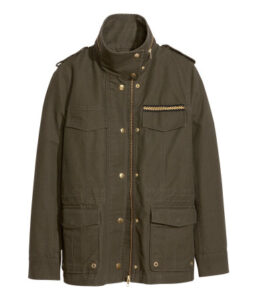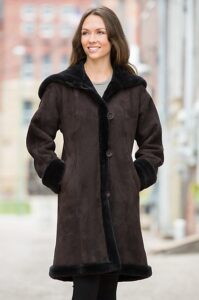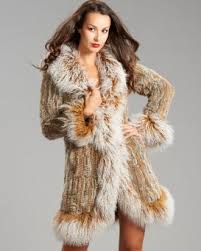I spoke on Monday about natural fibre coat options I had found. Today I’d like to share a few more ideas for more natural fibre jackets:
Canvas jackets – Canvas is a heavier cotton fabric that functions similarly to Ventile, absorbing water and swelling to block water penetration. Its fibres are not water resistant without some waterproofing treatment, either wax or chemical, though there should be more freedom in how the user chooses to treat the fabric. Canvas jackets come in single-layer construction, lined, and padded and lined versions, but are again more common in men’s styles. Watch for linings, as materials vary considerably. An unlined canvas coat can be waxed at home using allergen-specific safe waxes and/or oils.

Cotton Canvas Jacket from www.hm.com
This one is unlined and probably only available for a limited time from H&M. LLBean also carries cotton canvas jackets, among other major fashion brands. Searching for “canvas coat” or “canvas jacket” on Google will bring up a lot of fashion brand coats that fit into this category.
Canvas and Cotton Clothing has a wide variety of canvas jackets, but it is unclear whether they’re lined. They do claim to be 100% water repellent, which would lead me to believe that they may contain other materials, but a quick check with the company should make that clear.
This one appears to be unlined, which could pose a problem in the wide neck-area seams, but one could always sew cotton twill tape over top of these seams, or add their own lining.
Some more links. These may or may not have non-cotton liners; it’s always best to contact the company and check. Remember, often liners can be removed if necessary.
- Campmor
- The Nautical Company
- Midway USA
- Kakadu Trader
- Lapstone and Hammer
- Lure of the North
- CottonOn

Krista Shearling Sheepskin Coat from www.overland.com
Shearling coats – Designed for cold weather, these coats will keep you as warm as a sheep in winter. The coats are made from skins of sheep with the fur (wool) left on, usually worn with the fur side inward. Toscana is considered a luxury kind of fleece, and is often used as trim on other skins. Merino is soft and less itch-prone as well, but easier to find. The best sheepskins come from Spain and Portugal, with the lightest coming from South America (think Ikea sheepskins; I hear that’s where they get theirs). Prices range from $350 through the many thousands of dollars. The most common price range for “affordable” shearling coats is US$1000-1500. Shearling coats come with either a shiny polish or a matte suede finish, with the shiny finish being more durable and water-resistant. Allergy-prone buyers should be aware that the finish used on shiny leather [LINK to my blog page] is often made of polyester (propylene glycol/polyethylene glycol allergy issue) or urethane (epoxy/colophony/pine resin/rosin allergy). Also, leathers can be treated with metal-based chemicals as a part of the tanning and processes. Cleaning requires visiting a specialized fur cleaner or trying homemade dry cleaning methods. Shearling coat suppliers:
Overland has one of the best selections of shearling coats anywhere. Their prices tend to range from US$800-4000, in a multitude of styles, colours, trims, and finishes.
Sickafus has a large number of different styles, mostly more rugged than the ones from Overland. They appear to make these jackets in-house. Their prices are slightly better, and they will make a few of their coats to order, as well as maintaining a clearance section on their website.
Shearling coats are everywhere, but the two above have a great selection.

Source: www.furcoats.com
Fur coats – While fur is a faux pas in some circles, with an allergy sufferer I really recommend going with what works, and if that’s fur, so be it. Fur coats are usually worn with the fur side out, which could make them more prone to collecting airborne allergens. They also suffer from the same cleaning and chemical problems that shearling coats do. Some furs are designed to be worn fur in or fur out, but most furs have a synthetic lining. If you have a good tailor, it should not be a problem to switch out the lining for something more allergy-friendly. As far as fur types go, raccoon, sheep, and mink are said to be some of the most durable, and rabbit one of the least durable. Pet allergy sufferers should avoid anything in the canine family, including coyote. Mink is said to be one of the best for allergy sufferers, but it is also more pricey.
Wool – Wool fill jackets are limited on the market; down fill is a lot more common. The two kinds of wool-filled jackets I found both contained a lot of synthetic materials in the lining and outer. Boiled wool or other wool jackets are much more readily available, in both men’s and women’s tailored and less-tailored styles. Lined ones typically block the wind better, but usually contain synthetics. Unlined wool coats do not block wind well. Wool is a great material in that it doesn’t lose its insulative properties when wet, but it also collects airborne allergens more readily than synthetics. Wool is difficult to wash, shrinking small amounts over time even if no heat is used in the wash cycle and they are hung to dry. Watch out for “wool blend” coats, or wool blended with materials such as nylon (possible isothiazolinone reaction) or polyester (propylene glycol/polyethylene glycol reaction).
Whatever kind of jacket you choose, consider layering for best effect. If you plan your layers carefully, two jackets could last you for all possible seasons.
Have you found other natural fibre jackets/coats/parkas? Share in the comments below.
